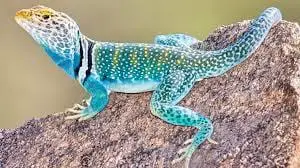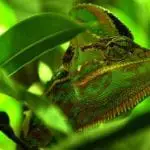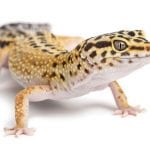You’re dead set to owning a collared lizard when someone tells you it’s impossible to keep a collared lizard in captivity. Do you proceed with buying one from an exotics store, or should you abandon your dream?
A question popped up in a popular reptile pet site and forum asking why are lovely collared lizards not so popular as pets? The person who asked the question said that these lizards should gain more exposure because of their lovely colors, but why aren’t these as popular as the gecko or the chameleon?
For advanced lizard owners only
A short answer is because of the collared lizard’s diet and their handling needs. Collared lizards (Crotaphytus spp.) are very showy and can be seen with almost all color hues on its skin. Adult males are more colorful than females. And apart from their rare beauty, these are very active and need a special kind of diet.
Described as tiny velociraptors, these lizards have huge appetites and will eat almost anything like smaller lizards and smaller vertebrates. They eat all kinds of bugs, but they won’t be satisfied with just one or two, they need a huge bunch to please their large appetites.
Unique metabolism
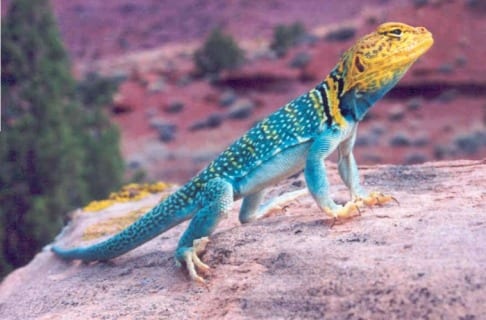
Another term for collared lizards is “collies.” Collies eat this way because they have a unique metabolism. They have super-fast metabolisms that they need to consume a lot of food to remain healthy.
The collared lizard has a daily routine that starts when the sun is up. This lizard will climb on top of a rock or a gazing rock to check out its surroundings and to bask. It has to attain its optimum hunting temperature before it can start hunting for food.
Climbing this rock provides a vantage point with a view of the terrain for 20 or more feet. The lizard keeps an eye on potential prey on the ground below. When it sees something worth its while, it will dive down and run after it. Despite being satiated because it has not eaten during the night, it will use its powerful muscles in their heads to clamp down and kill its prey. Sometimes, the prey can be as large as the predator, and it can take time for the collared lizard to incapacitate it. But sure enough, the prey will eventually succumb to death.
When you keep this lizard in captivity, it needs to perform this behavior even in a tight enclosure. This is the most common drawback that pet owners find when caring for a captive collared lizard for an extended period. You need to create a tall enclosure with a large surveying rock in the middle for the lizard to use when it catches prey.
Also, the keeper’s inability to give the lizard a variety of foods in sufficient amounts is often what leads to a collared lizard’s demise. Compared to the common captive chameleons, most pet owners don’t understand the responsibility they have when they get a collared lizard as a pet. They are unaware of how much food is required to maintain even one collard lizard in good health. And even if they are aware of the collared lizard’s humungous appetite, they are unable to supply it. This is why most collared lizards are unable to survive in captivity.
It’s hard to provide the right habitat
Collared lizards inhabit rocky areas with only a few plants. Naturally, you can find these in boulder-strewn hillsides and rocky outcroppings. Compared to other lizards who simply prefer to sit on trees or remain on the forest floor, the collared lizard dig under boulders to sleep and to rest, especially when they are full. These lizards may also use these areas to lay their eggs.
In captivity, it’s not that this lizard is picky about their habitat, they are far better living in a natural environment rather than cage them or place them in an enclosure where their movements are limited. It is not sure if this lizard needs companions, but usually, these are found alone in some boulder or hillside. It is only during the breeding time that the collard lizard looks for the company.
It’s a challenge to breed collared lizards
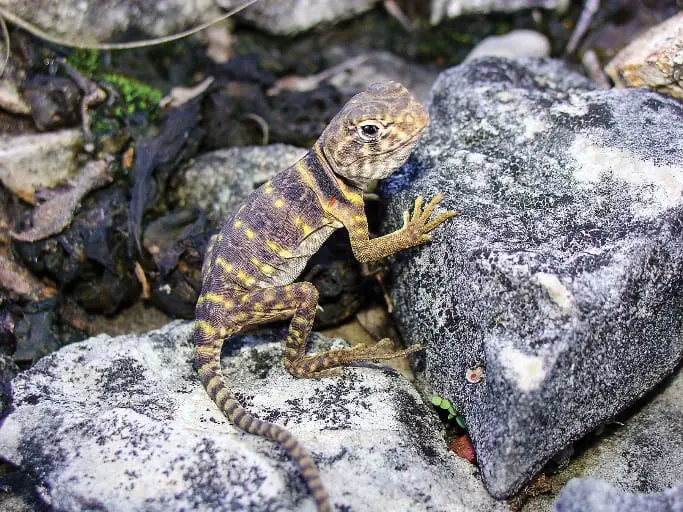
Some lizard owners prefer the common gecko or chameleon when breeding lizards because they find the collared lizard as fussy breeders. These need the right environment to mate, which is usually done on the ground.
Collared lizards can grow from 8-14 inches, including the tail. The colors and markings are diverse in collared lizards, and the male and female are sexually dimorphic. Males are green to tan with some distinct patterns of dorsal spots and bars to which may sometimes look a speckled pattern across the lizard’s belly.
The male collared lizard can also exhibit striking yellow and orange head colors while the female collared lizard tends to be less colorful but only during the breeding season when they display bright orange side spots. Both male and female collared lizards have very prominent collar-like black bands around their neck, and this is why they are called collared lizards.
The collared lizard courts and mates on the ground during the spring until early summer. The pair needs to have the right conditions to mate, and if this is missed, mating can be postponed for weeks, months, or to the next breeding season.
The average clutch size for this colorful lizard is around 4-6 eggs, and 1-2 clutches are produced annually under the right conditions. The female deposits her eggs in underground burrows underneath rocks or loose sand. The incubation period for the eggs is 53-94 days. It was also noted by experts that the parents don’t exhibit any parental responsibility in caring for their eggs and their young. The female also doesn’t consider the safety of her eggs when she lays them. They don’t look for a safe place to lay their eggs, and thus, these are delicious treats for predators.
And starting as a breeder can also be expensive since you need to buy a pair of collared lizards. Consider that a breeding mature pair will cost around $200, and of course, the size, age, and color markings matter a lot when pricing a lizard as gorgeous as a collared lizard.
Understanding collared lizard food and behavior
Collared lizards are among the most misunderstood creatures. It’s cousins like the gecko, and other lizards prefer to hunt and eat at night. They may remain inside their burrows in the morning only to come out of hiding at night when the air is cooler. However, the collared lizard needs to wake up early, as soon as the sun is up to enhance its body temperature and then hunt for food. It won’t wait for a cool time of day to look for food because it has to eat, eat and eat.
Collared lizards are most active during the warmest part of the day. They will stalk their prey on the ground, too, not just on top of basking rocks. And since they have a fast metabolism, they need to eat until they are full. You can tell that the collared lizard has had enough food when you see them basking on rocks.
The collared lizard is insectivorous and carnivorous. Their diets may consist of plant matter and may vary its diet depending on what kind of food is abundant. In the wild, food can range from grasshoppers to small lizards. They may eat worms, caterpillars, and anything that they can see moving on the forest floor.
It’s expensive to own a collared lizard
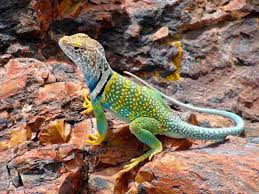
Because of the endless feeding frenzy to maintain a high metabolism, most pet owners find it very expensive to own a collared lizard. It’s a steep gamble because you might be able to keep to its voracious appetite for a few weeks, but soon, you won’t be able to keep up. Unless you have the budget for this lizard’s meal, then you can’t afford this lizard!
But there’s hope for a collared lizard fan. You can raise your food, but make sure to feed it a variety of food because it can easily get boring with just one kind of food. For instance, feeding it, grasshoppers will eventually tire it out. It will lose interest, and hence it will eventually starve, and this will severely affect its health.
So, raise grasshoppers, crickets, mealworms, superworms, pinkie mice, and many other kinds of food that this lizard eats. Also, give your lizards the right supplements. To avoid metabolic bone disorder, give calcium supplements by dusting the food with calcium. Also, gut load insects with all kinds of supplements instead of just offering live food. If your collared lizard becomes too picky, then it won’t be able to survive.
It’s expensive to buy a collared lizard
As much as it’s very expensive to feed a collared lizard, it’s also very expensive to buy one. Because of its very intense coloration, these lizards tend to be very costly. Lizards with the loveliest hues may cost anywhere from $100 to $150 each online. If you’re on a tight budget, you can go for a lizard that’s not too colorful for less than $50.
Owning a captive lizard can become more expensive, considering several factors. You must consider a large enclosure for your pet; ideally, an enclosure that’s tall and wide so your pet can sit on top of a rock and check out its area. Also, it needs a large space to hunt. It has to see prey moving so it won’t become bored while inside its enclosure.
A captive collared lizard also needs the correct lighting, humidity, and temperature, and these can only be accomplished using the right kind of equipment.
Possible solutions to make collared lizards live better in captivity
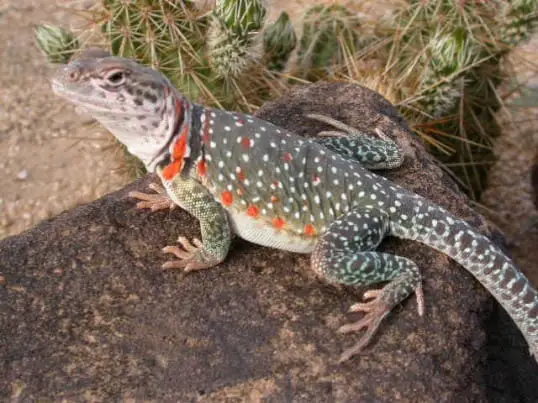
Now that you know how hard it is and how costly it is to care for a collard lizard, let’s focus on how to make a collared lizard’s life better. It starts at buying the right collared lizard pet. If you’re able to select the lizard from a group, you should prefer a young lizard from an adult one because these lizards can be trained to eat in a schedule or be used to a particular type of food.
If you’re starting with baby lizards, train it to eat on a schedule but don’t starve it. For example, a collared lizard in captivity will need to eat a cricket an hour; you can give your baby lizard as many crickets as it would like, but after an hour, let it take a rest until the afternoon. Take note that baby lizards need more protein to grow and develop their bodies, so as they grow, reduce the number of insects you feed it.
As mentioned, you can make your own lizard’s food just like what most pet owners do. Just think about this. Making your food is one way to avoid giving your lizard food that may contain fertilizer or pesticides, which can affect your pet’s health. Never get food from the wild! And if you can, find local insect breeders as pet food and buy your food directly. This makes it more affordable, and thus caring for this pet becomes more bearable.
Aside from the cost of food for your collared lizard, you can ease the cost of buying a new cage or enclosure by using old enclosures or cages available. Repaint an old one, fix a cage with a broken door, or if you have lumber and tools, then you can DIY an enclosure for your pet.
Instead of buying accessories like perching rocks, substrate, or lighting, you can make use of what you have. You can recycle old materials and accessories for as long as you clean these thoroughly. Disinfect an old enclosure and rinse well. Wipe the cage clean before you place your pet in. And if you are thinking about the cost of buying a collared lizard, you can ease the cost by buying directly from a breeder.

